Garden Glimpses: Autumn Equinox
It’s that season again – fall! Cool, bright days, crisp clear nights, nature pulling out all the stops on its color palette, displaying all its tones in a vibrant burst of life before winter’s slumber. Autumn is my favorite time of year, and not just because it includes Halloween! Before the ghosties and ghoulies and long-leggedly beasties come out to play, there’s falling leaves, tangy apple cider, pumpkins and gourds galore, and a riot of color in the September garden.
Even in my postage stamp backyard in Philadelphia, I allowed fall-blooming native plants to thrive, and I made sure to bring at least a few of each when I moved to the new house in 2020. Not that there’s any lack of natives in the general area, but the field behind the house had been periodically clear-cut for livestock feed for years, limiting the amount of available seed locally, and was in the process of housing development which would further erode the biodiversity.
Even so, I was rewarded this year by, not just a wide dissemination of those “starter sets” of autumn wildflowers which I brought with me, and which bloomed but sparsely their first fall here, but the invasion of additional native species, some of which I hadn’t seen before.
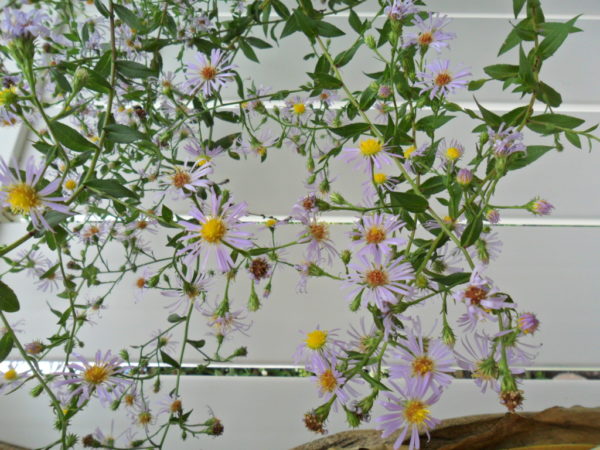
Among these is my treasured Michaelmas daisy, a tall, willowy aster with medium-lavender blossoms and vivid yellow centers that fade to rust. This magically appeared last year in a small foundation planting just outside the garden gate, a wondrous ambassador of the autumn season. Bloom starts in mid-September and continues well into October, and what was a stunted bit of floral accent in its first year, just three stalks barely three feet high, is now a mature clump of a dozen sturdy stems, some nine feet tall, which threatens to dominate the entire display. It’s definitely time for division, which I will attempt after Halloween, moving at least half of this clump into the garden proper, where I will enjoy it more often.

Just behind it, on the inner side of the garden fence, is an imported stiff aster which has also spread voluminously from its premiere season. With a growing habit similar to the Michaelmas daisy, but with leaves even more delicate, this native is covered in smaller, white blossoms, also yellow-centered, which, at full bloom, gives the impression of a living snow squall. Swirls of white cascade in arching billows of blossom, filling the entire corner where it’s planted. I had to wire it back to the fence for fear it would crowd out the new witch hazel sited next to it, and it’s certainly another candidate for division and transplant late this fall.

Stiff aster is by far the dominant strain of aster on the property, but there’s also an unidentified variety, similar, but with the palest lavender blossoms imaginable, and another unnamed species with even smaller white flowers than the stiff aster, but larger leaves. To these I added another native this year, purchased at “Edge of the Woods”, a local native plant nursery. The so-called “Blue Aster” is really a vivid purple, and a lovely addition to the seasonal color palette, with larger, flattened blossoms that radiate with deep yellow centers fading to orange-brown.

Goldenrod is another glory of the season, though most of the local native varieties have faded from brilliant yellow to ocher brown by late in the month. Their heyday is late August through mid-September, but some stragglers growing in shadier areas are still vibrant and at peak. These can become leggy and need to be supported to prevent flopping when they bloom. Top-heavy, though sturdy-stemmed, they can’t sustain the weight of their voluminous bloom heads on six-foot stalks, especially after a heavy rain.
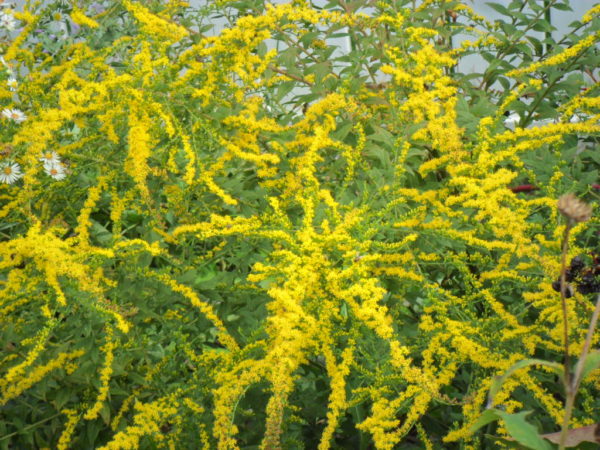
An antidote to that problem lies in another native I purchased this year, a goldenrod variety called “Fireworks.” This stunner blooms all along its stems, not just at the top, and remains a more compact and manageable four to five feet in height. It’s easy to see how it got its name, with long curling strands of blossoms popping with yellow floral bursts, like a Fourth of July skyline.

White snakeroot likes the woody edges, and is a great fill-in for the shade garden. Masses of fuzzy white blossoms come in small clusters on many-branched flower heads, glowing in the dusk like beacons lighting the way, keeping shadows at bay. It can be invasive, and spreads quickly, but is easily uprooted. This is also at peak as September wanes, and forms a lovely backdrop for showier fall annuals, like chrysanthemums.

Speaking of which, last year I planted eight mums which I purchased locally, supposedly winter-hardy varieties, in a wide range of colors. As expected, the return rate was not impressive, but I did manage to retain a pair of a lovely medium purple strain – apparently that variety is hardier than the others. They are as full and budded as last year, forming bushy round mounds of bloom, so I hope they’ll continue to thrive for many more seasons.

I bought a few more mums this year to supplement the color scheme – yellow, rust and bicolored orange and gold, as well as a dark purple aster. These, with some potted sedums, were added to my “Autumn Bounty” display outside the front gate, along with a corn shock and a couple hay bales. Here will be piled dozens of pumpkins and gourds, from tiny Jack-be-littles to large Cinderella pumpkins, green gooseneck gourds, flat white disk pumpkins, and a host of medium-sized offerings in blue-grey, pink, yellow and orange. An old scarecrow friend and a small forest green wooden wagon complete the scene, which is lit at night by a trio of solar-powered spotlights.
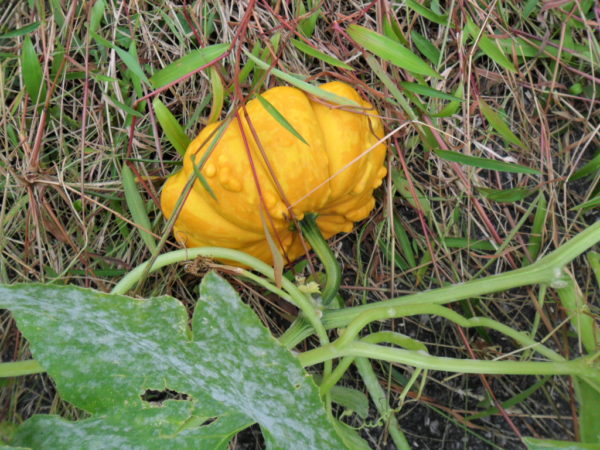
Some of the gourds displayed are home-grown, volunteer descendants of rotted specimens from last year’s display, somehow missed in the post-Thanksgiving clean-up. These seeds spouted and took root where they lay, providing an interesting vine with large, bright yellow blossoms in the summer and now fruiting in the fall. The fun thing about gourds is that they cross-pollinate so readily, you never know what you’ll come up with, regardless of the parent plant. One volunteer this year is a bit larger than most Jack-be-littles, and a paler yellow in color, but with random knobs like a warty gourd.
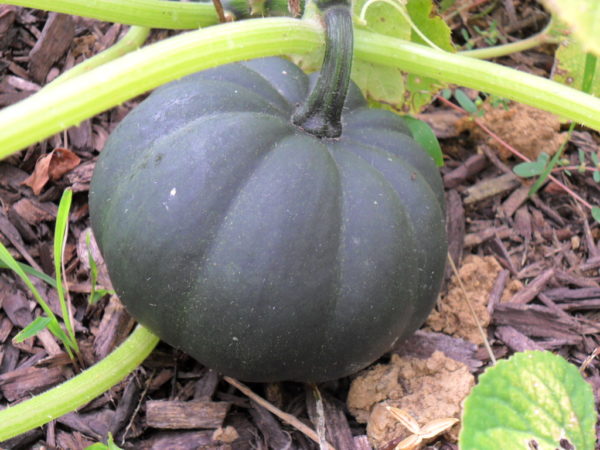
I also intentionally planted one new variety this year – Black Kat, a fist-sized little beauty that purports to be an actual black pumpkin! Google images shows some that are truly black, others that are more of a deepest green. I found these in a specialty seed catalog last winter, ordered, and planted a hill of five seeds on the sandmound in June (pumpkins like warmer weather to germinate, if you start them too early, they’ll just sit there anyway until conditions are right). Four came up, but unlike most gourd varieties, they didn’t vine. Rather, like their close relatives the cucumbers and summer squashes, they formed bushy mounds, and were very well-behaved. This may have limited their yield, however; despite fairly prolific bloom starting in late July, I have gotten just one mature fruit per plant. So far, these are inclining to the “dark green” end of their color spectrum, but they are still a unique and attractive fruit, and I won’t harvest for several weeks yet, not until the plants have died back. Perhaps their color will deepen to black in the meantime.
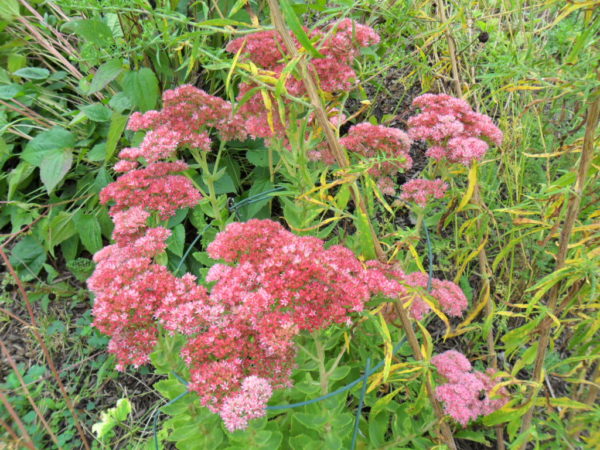
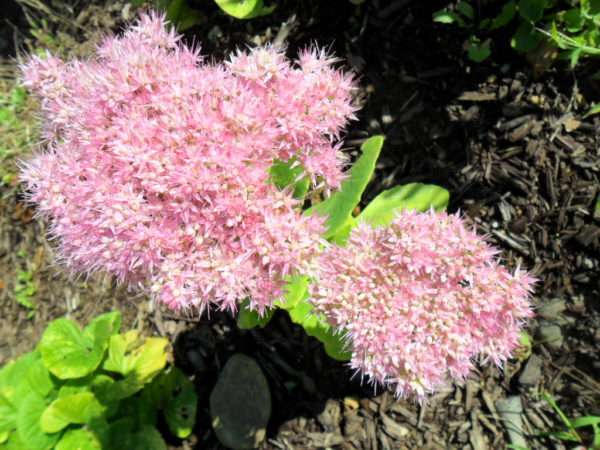
Of course, in addition to the natives, there are purchased plants that light up the fall garden as well, especially sedums. I’ve been expanding my repertoire of these, with new additions having purplish or chocolate brown foliage. Most of these have run their course by the equinox, but the aptly named “Autumn Joy” variety is just at peak. This sturdy, drought-tolerant succulent grows to between two and three feet tall, and sports masses of flat disks of starlike blossoms, opening pale pink but maturing to a color which is borderline ruby. Long-lasting but with no fragrance, sedum makes a great cut flower for arrangements, fresh or dried.
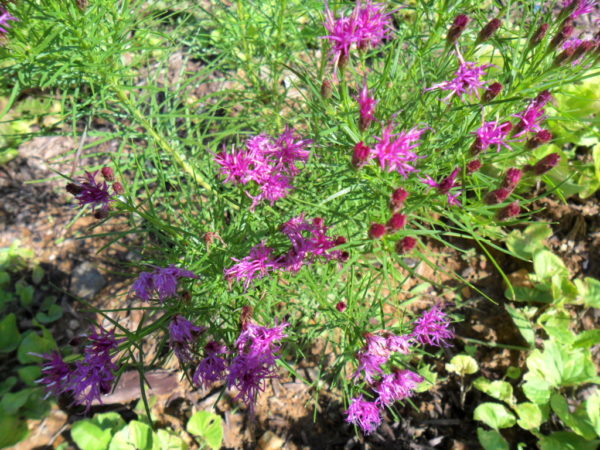
Ironweed is another late bloomer, new to me. About 18” tall, its delicate foliage is topped with fuzzy brushes of purple-red. “Autumn gold” helianthus is heavily budded, but has yet to bloom for me in this its first year in the garden, so I’m not quite sure what to expect. As the name implies, it’s a vivid yellow color, daisy-like in appearance.

Also keeping its powder dry is Montauk daisy, a very late bloomer indeed! With leaves of an almost succulent-like appearance, this woody-stemmed perennial with saw-toothed emerald foliage is more shrublike, and can be cut to the soil after blooming or left intact, to build upon itself in the following year. I have two of these, one a baby from an established clump in an old friend’s garden, giving it nostalgic, sentimental appeal, and a second one which I snagged on a pumpkin-buying tour of Lancaster late last October. Halloween is just about the time when these will reach peak; for now they are also heavily budded, about to reveal their blindingly white-petaled flowers with sunny yellow centers.

Some shrubs begin to show interest at this time of year also. My chokeberries were planted last fall, and this is the first they have fruited. Well, my red chokeberry bloomed and fruited; the black did not. Apparently there is a limit to its shade toleration, and at the base of the maple, this may have been exceeded, but I’ll leave it in situ for one more year, just to be sure the location isn’t right, and its lack of fecundity isn’t just a side-effect of its transplant. The berries were secondary to my choice of these regardless, though birds do prize them. I bought them for their stunning fall color, with vivid red-orange foliage, a preview of which I got during a drought in the summer, when a few leaves changed into their autumn robes. No sign of a general transformation as of yet, but fall foliage is at its peak here in mid-October, so there’s still time.
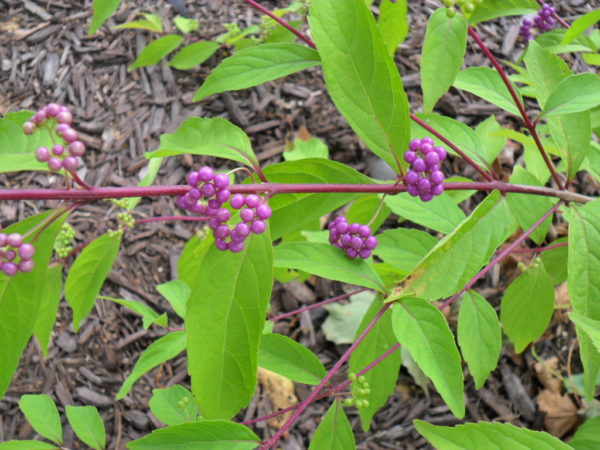
Late this August I took advantage of an end-of-season plant sale at “Point Phillip Perennials”, my local source, to pick up a Beautyberry. This attractive shrub sports clusters of small purple berries at regular intervals along the stems, very attractive for holiday bouquets. Their leaves turn a pleasant pale yellow, brightening up the shady area under the maple, which colors to vivid amber yellow as October wanes.
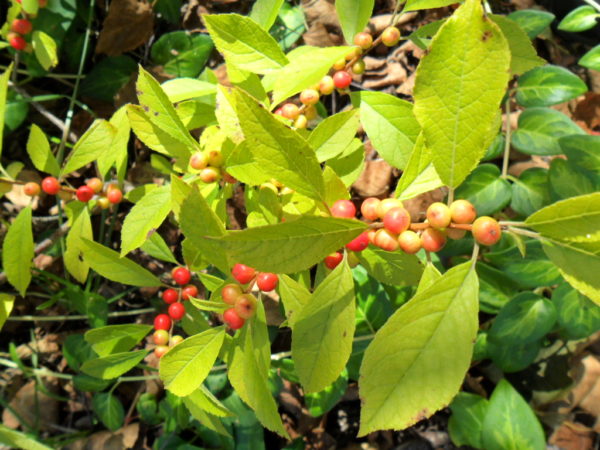
Also coloring now are the fruits of hollies and winterberry; the latter have done especially well this year, and though just a foot and a half high, are thickly berried, which will stand out starkly once their leaves have been shed. An old potted holly which I had tubbed in Philly and brought with me for transplant into the soil has seemed rejuvenated by the change. It always bloomed well in its old location, and developed jade green berries in the summer, but most fell off before maturing. This year, though its limbs are still spindly and sparse, it sports more clusters of bright red berries than I have ever seen on it. The new hollies have performed acceptably also, despite a setback from broken branches due to last February’s blizzard.

Alas! It’s weeks yet until the maple colors, and the orange-rust Chinese dogwood flares in the front yard. Right now it is covered with its bizarre, pinky-red bumpy fruits, which nobody but the wasps seems to enjoy. All too soon they will litter the walks and driveway, their yellow centers crushed and staining where we walk or park. The new native dogwoods in the garden will color soon, too, and have put on quite a bit of height this season, affording more of their red-orange foliage to enjoy. Alongside them the oakleaf hydrangeas will transform into burgundy-red beauties, while the arborescens variety, and some nearby hostas, will color golden yellow.
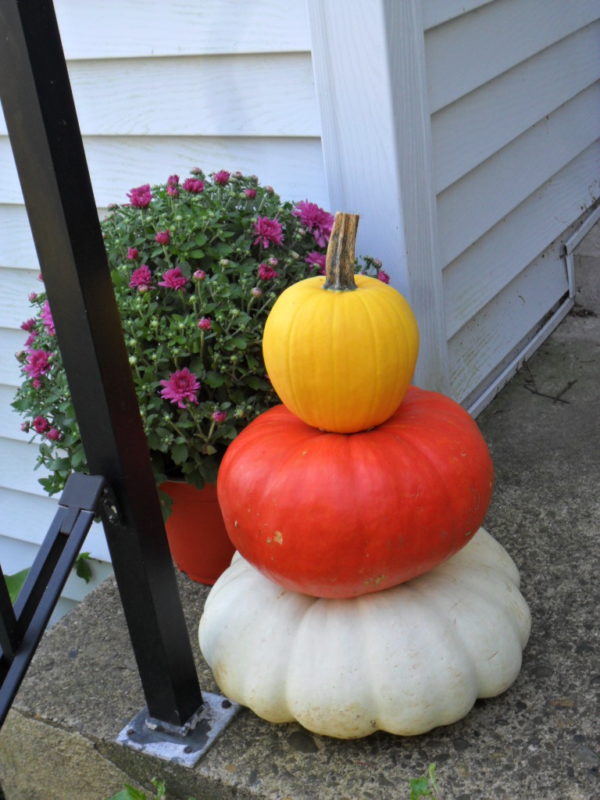
But these are next month’s glories. For now, time to add a shot of amaretto to that fresh-pressed cider, grab a pumpkin doughnut, and pull out that copy of Amy Goldman’s “The Compleat Squash” for a little seasonal reading material. All hail Autumn!
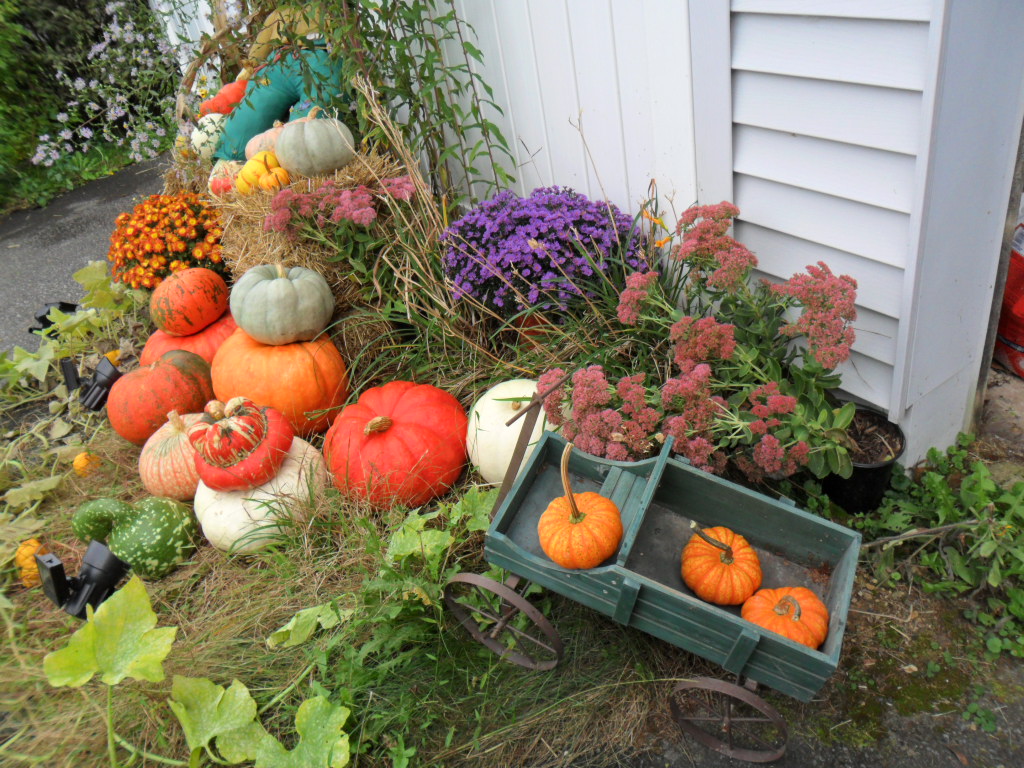

2 comments, add yours.
Laurien
Hi Alex! Thanks for taking your readers on a fall tour of your garden! I’m impressed with all the native plant varieties and that you are lucky enough to have a native plant nursery nearby! I was especially taken with the beautyberry which I’ve never seen before. I hope your neighbours enjoy your seasonal display that is so artfully done! Happy Fall!
Susan
Gorgeous pumpkins, Alex! I love the array of shapes and colors, and especially, the Black Kat… I hadn’t see that variety before. Stunning, I’ll bet, as a jack o’lantern.